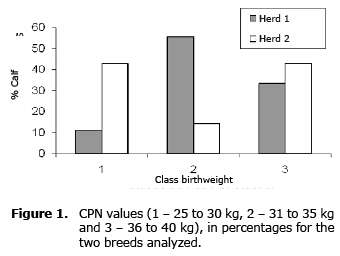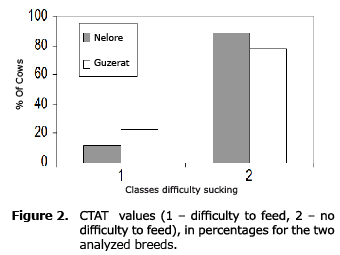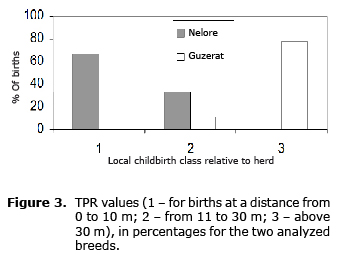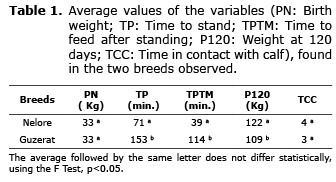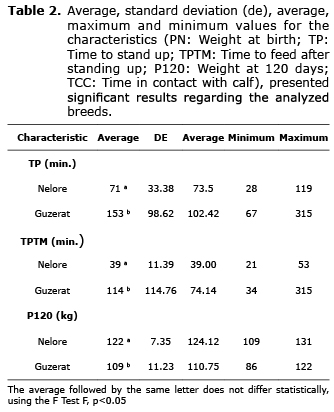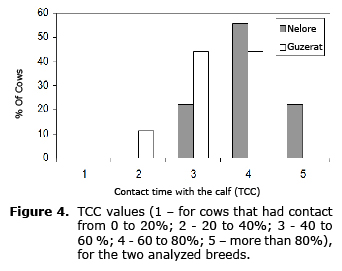Services on Demand
Journal
Article
Indicators
-
 Cited by SciELO
Cited by SciELO -
 Access statistics
Access statistics
Related links
-
 Cited by Google
Cited by Google -
 Similars in
SciELO
Similars in
SciELO -
 Similars in Google
Similars in Google
Share
Revista MVZ Córdoba
Print version ISSN 0122-0268
Rev.MVZ Cordoba vol.20 no.1 Córdoba Jan./Apr. 2015
ORIGINAL
Maternal-calf relationships and their influence on calves up to 120 days
Relaciones materno-filiales y su influencia en terneros hasta los 120 días de edad
Emanoela Souza-Conde AL,1 M.Sc, María V. Andrea,1* Ph.D, Marcy Conde L,1 Ing Pesca, Jesus Delgado-Mendez,1 Ph.D, Fagner C. Souza,1 Ing Agr, Mateus Paranhos da Costa JR, 2 Ph.D, Thereza CB de Bittencourt dos SC,3 Ph.D, Kaliane de Oliveira N,1 M.Sc.
1Universidade Federal do Recôncavo da Bahia. Centro de Ciencias Agrarias, Ambientales y Biológicas. Rua Rui Barbosa, 710, Centro. Cruz das Almas- BA, Brasil.
2Departamento de Zootecnia, Faculdade de Ciências Agrárias e Veterinárias, UNESP -Via de Acesso Prof.Paulo Donato Castellane s/n. Jaboticabal, SP, Brasil.
3Universidade Federal da Bahia - UFBA. Escola de Medicina Veterinária. Av. Adhemar de Barros, 500 - Ondina - Salvador-BA, Brasil.
*Correspondence: mvander@ufrb.edu.br
Received: October 2013; Accepted: June 2014.
ABSTRACT
Objectives. To research parental behavior and measure the weight of Nelore and Guzerat calves up to 120 days of age, collecting data from birth up to the first lactation. Materials and methods. Seven different corporal positions were considered to obtain specific data for each of the following categories: time to stand (TP), time to intend to feed after standing (TPTM), weight at birth (PN), weight at 120 days (P120), and time in contact with the calf (TCC). Additionally, independent variables were also evaluated, organized by class: weight at birth (CPN), number of calvings (CNP), order of calving in relation with the herd (CLPR), time of calving (CHP), and finally, hindering to feed (CTAT). Results. There was a significant result in favor of the Nelore race over the Guzerat race. The statistical averages for Nelore and Guzerat were: Time to stand averaged 71 and 153 minutes; time to intend to feed after standing, 39 minutes for Nelore and of 114 minutes for Guzerat. For variable weight at 120 days, Nelore reached an average of 122 kg, and Guzerat 109 kg. For the time in contact with the calf variable there was no significant variance between races. Conclusions. Results showed the superiority of the Nelore race, considering it better adapted to local environmental conditions.
Key words: Behavior, calves, suckling, well being (Source: CAB).
RESUMEN
Objetivo. Investigar el comportamiento materno y observar su influencia en el peso de los terneros de las razas Nelore y Guzerat hasta los 120 días de edad, evaluándolos desde su nacimiento hasta el primer amamantamient. Materiales y métodos. Se consideraron siete posturas corporales diferentes, las cuales fueron usadas para obtener las observaciones específicas en cada una de las siguientes categorías: Tiempo para ponerse de pie (TP), Tiempo para intentar lactar después de ponerse de pie (TPTM), peso al nacer (PN), peso a los 120 días (P120) y tiempo de contacto con la cría (TCC). Se evaluaron las variables independientes, organizadas en clases: peso al nacer (CPN); número de partos (CNP); orden del parto en relación al rebaño (CLPR); hora del parto (CHP) y obstaculización de mamada (CTAT). Resultados. Se obtuvo un mejor resultado en los terneros de la raza Nelore en relación a los de la raza Guzerat. Los promedios estadísticos para Nelore y Guzerat fueron los siguientes: TP con media de 71 y 153 minutos; TPTM de 39 y 114 minutos; P120 con 122 kg para terneros Nelore y 109 kg para los de la raza Guzerat. La variable TCC no obtuvo una diferencia significativa entre las razas. Conclusiones. Los resultados demuestran una superioridad para animales de la raza Nelore, lo que permite inferir que poseen una mejor adaptación a las condiciones ambientales locales.
Palabras clave: Amamantamiento, bienestar, comportamiento, terneros (Fuente: CAB).
INTRODUCTION
The birth process is a dynamic event and is fundamentally important to mammals since it guarantees the continuity of the species (1). Maternal behavior of different species decisively affects the well-being and development of newborn animals. According to Paranhos et al (2) and Hötzel and Machado Filho (1), changes in maternal behavior are synchronized with the development of calves and with feedback between mother and calf that provokes regularity of a determined behavior. Much of this behavior is activated during the last stages of pregnancy or at the moment of calving.
According to Toledo (3) and Schmidek et al (4), an adequate analysis is necessary in order to evaluate the behavioral characteristics related to maternal abilities and a satisfactory lactation. Two aspects are outstanding: the survival of the calf (including the capacity of the cow to wean a calf every year) and the production of milk (considering production and sanitary characteristics). However, there are controversies over what should really be considered. Regarding maternal ability, two points stand out: the ethological evaluation and the potential growth of the calf.
Thus, the phases when the calf is still under maternal care and the later interruption of this relationship at weaning are considered highly important for the future development of the calf. According to Paranhos da Costa et al (5), behavioral patterns of cows and calves during the prenatal period can be associated with survival and the future development of calves and maternal performance of cows in later calvings. The above author mentions the fact that some calves do not feed during the first six hours of life, and that this becomes significant when the percentage of incidence of this event is linked to survival rate, incurring also additional handling difficulties such as artificial lactation, calf adoption, and cow retention to be able to apply forced lactation.
With the objective of comparing maternal behavior of bovine breeds in the semiarid region of Bahía as well as observing its influence on weight at 120 days, calvings of Nelore and Guzerat cows were evaluated on a specific property in the abovementioned state of Brazil under local climactic conditions.
MATERIALS AND METHODS
Study location. This study took place at the Hacienda Soraya, in Serra Preta municipality in the Brazilian meso-region of Centro Norte Bahiano, the Feira de Santana micro-region, with semiarid climactic characteristics, 161 km from the capital city, Salvador. The municipality has an extension of 540.9 km2, and the coordinates are: latitude 12°11'15"S, longitude 39°18'45"W and altitude 311 m.
Samples. Two groups of Zebu animals were defined: 9 Nelore cows and 9 Guzerat cows. The animals were handled in a maternity paddock (2 ha) with “urucroa” (Urochloa moçambisensis) forage pasture under a continuous feed system close to the corral. The animals were taken to the paddock 15 to 20 days before giving birth. Births occurred in the period from March to July.
The Nelore and Guzerat breeds are part of the Nelore Brazil and Guzerat Brazil Programs.
General description. In order to measure animal behavior, direct observations of the activities of the cows and calves took place during the first hours after calving. Calvings that took place from 4 hours until 23 hours were observed, and observation started when cows presented characteristics that indicated imminent birth. Data began to be recorded after the complete expulsion of the calf, observing body posture and activities of both the cow and the calf. Focal samples and continuous recording was done in order to be able to record observations on events occurring in a short space of time.
Following the model adapted from the etiological chart “Etograma de Trabalho” (6), the following behavioral categories for cows and calves were defined in relation to body postures:
Lying down. The animal was not supported by any body part, whether on the side or ventral;
Standing. The animal was supported on four legs;
In circular movement. Moving around its own body, staying in the same place;
Move. When the animal moved its legs and left the place it occupied before.
The following categories were defined specifically with relation to cows in post-partum activities:
Contact with calves. Activities consisting of smelling, licking and pushing calves, in direct contact;
Without apparent activity. When the cow is motionless, without any apparent movement;
Feeding difficulties. Activities that constitute impeding access of the calf to the udder; backing up, walking in circles, kicking and butting the calf.
Regarding calf activities, the following categories were also considered:
Lying on side. When in lateral lying position;
Lying down. When in sternal position;
First movement. When it moved its head, turning to get into the sternal position;
Standing. Time taken to stand up;
Time the calf takes to begin to feed.
Trying to feed. When the calf found the udder and tried to attach itself;
Lactation. When the calf had the udder in its mouth, sucking.
Recording was terminated immediately after the calf was able to start sucking or, if this did not occur, after five hours of observation. Cases that needed help (two Guzerat cows) were not included in the data recorded.
After field activities, data was recorded and variables calculated. When the calf was not able to feed, when it could not get up within six hours, 315 minutes for latencies (standing and trying to feed) was attributed, which was defined by the total observation time plus 15 more minutes. When these behavioral categories took more than 5 hours of observation, the maximum observation time value was assumed as representative of latency to stand up (TP), as well as latency to attempt feeding after standing up (TPTM).
Statistical analysis. Two sets of variables were defined: one for calf behavior and weight gain after 120 days, and the other for behavior of cows when with calves.
Four variables were considered for calves:
Time to stand up (TP). Time that the calf took from birth until standing on its four legs, firmly or unbalanced;
Time to try to feed after standing up (TPTM). Defined as the time the calf takes after standing up to attempt attaching itself to the udder;
Weight at birth (PN). Weight of the calf the day following birth;
Weight at 120 days (P120). Weight of the calf at 120 days.
For cows, the variable was:
Contact time with the calf (TCC). Defined as the percentage of time that the cow was in contact with the calf in relation to total observation time in activities such as licking, smelling and touching the calf, caring for and encouraging calf movement.
Values obtained in the field were grouped into classes (from 1 to 6, differentially) from which the following independent variables were created:
CPN (calving weight class): 1 - calves from 25 to 30 kg, 2 from 31 to 35 kg and 3 from 36 to 40 kg;
CNP (calving number class): 1 - first calving, 2 - second calving y 3 - third calving or more;
CLPR (calving location in relation to herd class): 1 - for calvings 0 to 10 meters from the flock, 2 - for calvings 11 to 30 m and 3 - for calvings greater than 30 m;
CHP (hour of calving class): 1 - for calves born between 4 hours and 7 hours; 2 - between 8 hours and 10 hours; 3 - between 11 hours and 13 h; 4 - between 14 hours and 15 hours; 5 - between 16 hours and 18 hours and, finally, 6 - between 18 hours and 23 hours;
CTAT (feeding obstacle class): 1 - obstacles and 2 - no obstacles.
For PN variables (in kg), TP (in minutes), TPTM (in minutes) and P120 (in kg), variance analysis was done (ANOVA), using the version 9.1 statistical program (7), as well as measurement estimates, minimum and maximum values with their respective standard deviations, and finally, error calculation of these variables. After this analysis the F Test was applied at a level of 5% probability for comparing averages, in order to detect differences present in the F Test in both breeds (Nelore y Guzerat) for TP, TPTM, P120.
The TCC variable was classified as follows:
1 - for calved cows that maintained contact from 0 to 20%;
2 - from 20 to 40%;
3 - from 40 to 60%;
4 - from 60 to 80% and
5 - above 80%.
These percentages were determined from the total observed time versus the time that the cow was in contact with the calf.
RESULTS
Regarding the weight and mortality of calves (Figure 1), there was a greater frequency of calves with intermediate weights (31 to 35 kg), indicating the absence of mortality in the entire analyzed herd (0% for the two breeds).
It was observed that approximately 80% of the cows had multiple births. This fact made comparing the results of both analyzed breeds easier.
In relation to CTAT, approximately 90% of Nelore cows did not impede their calves when these tried to feed while 20% of Guzerat cows created some obstacles when their calves tried to feed (Figure 2).
In this study, it can be observed that more than 55% of Nelore cows calved at night (between 18 hours and 23 hours) while with the Guzerat cows (60%) calving was distributed in the first two classes (class 1 - between 4 hours and 7 hours and class 2 - between 8 hours and 10 hours) coinciding with the results found by Toledo (8) for positive TP correlation, where probably better temperatures and air humidity helped improve imprinting.
In this investigation it was possible to observe that the TPR value was superior in Guzerat cows, where 80% of them gave birth at a minimum distance of 30 m from the flock (Figure 3).
Results presented in table 1 show significant values for the studied TP, TPTM and P120 variables, where the Nelore cows were outstanding in comparison to the Guzerat breed.
Average TP values of 71.22 and 153 minutes were found for the Nelore and Guzerat breeds, respectively. Considering this variable, some Nelore cows presented minimum values of 28 minutes, while the values were 67 minutes for the Guzerat cows (Table 2). This information was also obtained by Toledo (8) and Schmidek et al (4).
In table 2 the Guzerat cows presented minimum and maximum TPTM values of 34 and 315 minutes, respectively, for this variable. These values are possibly associated with the cow's agitation, which affects the behavior of the calf. As can be observed in the same table, data on Nelore cows also showed significant values for this variable (minimum 21 and maximum 53 minutes). It is deduced that an association could exist between TP, with average values of 71 minutes for Nelore animals and 153 minutes for Guzerat and TPTM animals, with average values of 39 minutes for Nelore cows and 114 minutes for Guzerat. The TCC variable (Figure 4) is numerically superior in Nelore cows, with class 3 variations (those that maintained 40 to 60% contact with the calves) up to class 5 (with 80% contact).
Regarding the weight of the animals, values found in the study show the significant effect of the abovementioned variables (TP, TPTM) in connection with P120, confirming the maternal ability of the Nelore cows to birth calves that are heavier at 120 days. The average values were 122 kg and the standard deviation 7.35, while the Guzerat breed presented an average weight of 109 kg and a standard deviation of 11.23. The TCC variable, in spite of having presented greater values for Nelore cows, was not significant.
DISCUSSION
Keeping in mind the calvings, questions arise concerning aspects such as: weight, calf behavior, cow behavior, birth hour, among others. The affirmation is that lighter calves perform better, have easier births, and avoid distocic or difficult births. However, studies have revealed that lighter weight calves with below average indexes present slower behavior, higher mortality index, more lactation difficulties (60%), and also higher TP (4).
Cows recognizing calves, an increase in the number of births and the age of the cow all acquire a positive correlation with parental commitment (8).
The first moments a cow has with her calf are fundamentally important, generating an experience for both (9). This characteristic has a direct influence on the calf's survival, since feeding time and colostrum quality could be compromised. Its ingestion is essential, since it contains proteins, casein, vitamins, minerals and immunoglobulins that will play a physiological and functional role in the neonatal development (8,10).
Cows develop peculiar characteristics when calving. Studies done by Schmidek (4) and Toledo (8) report that many can be observed during the cool hours of the day and at night, giving a sensation of thermic comfort and often of tranquility and safety, and result in more births at these times.
Regarding calving location related to distance from the herd, two extremely important periods must be kept in mind: the acknowledgment period, or response capacity (when pregnant animals are attracted to cows giving birth) and the selectivity period (when interference in the behavior of cow and calf can occur). Also, the farther the calving occurs with relation to the herd, greater is the performance of mother and calf (5).
According to literature (8), calving that occurs at a minimum distance of 30 m from the herd is satisfactory when considering the relation between the distance from the herd and the time the cows dedicate to the calves. However, this relationship was not observed in Guzerat cows, who presented lower TCC values.
The time to stand is a determining behavior for good bovine performance, and the success of this variable will have optimum results, including locating the udder and the first feeding. It is interesting to highlight that the care and experience of the cow will be decisive, since these activities help regulate body temperature, avoiding hypothermia and activating blood circulation, breathing and the motor and sensorial system (11-14).
Contact between the cow and the calf begin in the moments before birth begins with mechanical stimulus such as the dilatation of the cervix to facilitate the birth of the calf (1). These stimuli can possibly result in the cow's search to have greater contact with the calf, affecting the agility of the newborn, since greater contact means that the calf will stand quicker and it is hoped that it will try to feed quicker, thus lowering TPTM values. This variable, along with TP, could also show the newborn's strength.
To select animals for improvement, some evaluation criteria must be followed, since genetic evaluation is one of the most important tools presently used (15). Within those criteria the most outstanding is: weight at 120 days (P120), which has a direct correlation with maternal ability, determining a connection between the cow's performance and the growth of the calf (6,10).
Lira et al (16) suggest giving greater attention and selection to animals with greater pre-weaning weight, since it is the period of life when the animal grows and develops quicker, contributing to the reduction of production costs at that age.
This variable (P120) is one of the most important to be analyzed, since it influences TP, TPTM and TCC variables (17). The variable (P120) will reflect characteristics such as weight at 18 months, precocity and canal performance.
Maternal behavior observed showed superiority in the Nelore breed, especially in TP, TPTM and P120 variables.
Studies can contribute to minimize production costs, as well as using rational handling techniques oriented to increasing the weight of the calves and promoting herd improvement.
REFERENCES
1. Hötzel MJ, Machado Filho LCP. Bem-estar Animal na Agricultura do Século XXI. Rev Etol 2004; 6(1):03-15. [ Links ]
2. Paranhos da Costa MJR, Albuquerque LG, Eler JP, Silva JAII V. Suckling behaviour of Nelore, Gir and Caracu calves and their crosses. Appl Anim Behav Sci 2006; 101:276-287. [ Links ]
3. Toledo, LM. Fatores intervenientes no comportamento de vacas e bezerros do parto até a primeira mamada [Tese Doutorado]. Jaboticabal, Brasil: Universidade Estadual Paulista. Faculdade de Ciências Agrárias e Veterinárias; 2005. [ Links ]
4. Schmidek A, Mercadante MEZ, Paranhos da Costa MJR, Razook AG, Figueiredo LA. Falha na primeira mamada em bezerros Guzerat: fatores predisponentes e parâmetros genéticos. Rev Bras de Zootec 2008; 37(6):998-1004. [ Links ]
5. Paranhos da Costa MJR, Schmidek A, Toledo LM. Relações materno-filiais em bovinos de corte do nascimento à desmama. Mother-offspring interactions in beef cattle from birth to weaning. Rev Bras Reprod Anim 2007; 31:183-189. [ Links ]
6. Schmidek A, Paranhos da Costa MJR, Albuquerque LG, Toledo LM. Genetic aspects of vigour and maternal ability for Nelore and Guzerat breeds. Rev Etol 2003; 5:206. [ Links ]
7. SAS. Statistical Analysis System - SAS Version 9.0, 13th ed. Cary: Statistical Analysis System Institute; 2004. [ Links ]
8. Toledo, LM. Fatores intervenientes no comportamento de vacas e bezerros do parto até a primeira mamada [Tese Doutorado]. Brasil, Jaboticabal: Universidade Estadual Paulista, Faculdade de Ciências Agrárias e Veterinárias; 2005. [ Links ]
9. Broom M, Molento CFM. Bem estar animal: conceito e questões relacionadas- Revisão. Arch of Vet Sci 2004; 9(9):1-11. [ Links ]
10. Souza EA, Andrea MV, Santos CS, Paranhos da Costa MJR, Bittencourt TCBSC, Marcondes CR. Relações materno filiais e sua influencia no peso pré desmama de animais Nelore da Bahia. Arch Zootec 2009; 58(224):729-732. [ Links ]
11. Machado Neto R, Faroni CE, Pauletti P, Bessi R. Levantamento do manejo de bovinos leiteiros recém nascidos: desempenho e aquisição de proteção passiva. Rev Bras Zootec 2004; 33(6):2323-2329. [ Links ]
12. Machado TMP. Comportamentos afiliativos em vacas leiteiras a pasto, o papel da lambida [Tese Mestrado]. Florianópolis, Brasil: Universidade Federal de Santa Catarina, Centro de Ciências Agrárias; 2009. [ Links ]
13. Grandinson K. Genetic background of maternal behaviour and its relation to offspring survival. Livest Prod Sci 2005; 93:43-50. [ Links ]
14. Everett-Hincks JM, Lopez-Villalobos N, Blair HT, Stafford KJ. The effect of ewe maternal behaviour score on lamb and litter survival. Livest Prod Sci 2005; 93:51-61. [ Links ]
15. Madella-Oliveira AF, Quirino CR, Fonseca FA. Análise da genética do comportamento em animais de produção. Pubvet 2011; 5(12):1-13. [ Links ]
16. Lira TS, Pereira LS, Lopes FB, Ferreira JL, Lôbo RB, Santos GCJ. Tendências genéticas para características de crescimento em rebanhos Nelore criados na região do Trópico Úmido do Brasil. Ci Anim Bras 2013; 14(1):23-31. [ Links ]
17. Kippert CJ, Rorato PRN, Campos LT, Boligon AA, Weber T, Gheller DG, Lopes JS. Efeito de fatores ambientais sobre escores de avaliação visual à desmama e estimativa do parâmetro genéticos, para bezerros da raça charolês. Ciênc Rural 2006; 36(2):579-585. [ Links ]













